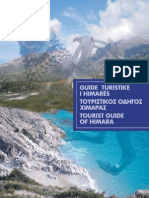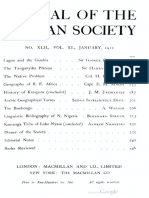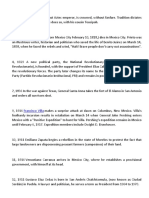Argentine Civil Wars
Argentine Civil Wars
Uploaded by
dzimmer6Copyright:
Available Formats
Argentine Civil Wars
Argentine Civil Wars
Uploaded by
dzimmer6Copyright
Available Formats
Share this document
Did you find this document useful?
Is this content inappropriate?
Copyright:
Available Formats
Argentine Civil Wars
Argentine Civil Wars
Uploaded by
dzimmer6Copyright:
Available Formats
Argentine Civil Wars
Argentine Civil Wars
Argentine Civil Wars
From top left: Battle of Arroyo Grande, execution of Manuel Dorrego, Battle of Pavn, death of Juan Lavalle, murder of Facundo Quiroga, Battle of Caseros, Battle of Famaill, Battle of Vuelta de Obligado. Date 18141880
Location Argentina Uruguay Result Federalization of Buenos Aires Sanction of a federal Constitution
Belligerents
Federales Blancos Unitarios Colorados
Commanders and leaders
Juan Manuel de Rosas Manuel Dorrego Justo Jos de Urquiza Francisco Ramrez Facundo Quiroga Chacho Pealoza Manuel Oribe Bartolom Mitre Bernardino Rivadavia Juan Lavalle Jos Mara Paz (POW) Domingo Faustino Sarmiento Fructuoso Rivera
The Argentine Civil Wars were a series of internecine wars that took place in Argentina from 1814 to 1880. These conflicts were separate from the Argentine War of Independence (18101820), though they first arose during this period. During this time Argentina was a failed state. The main antagonists were, on a geographical level, Buenos Aires Province and the other provinces of modern Argentina, and on a political level, between the Federal Party and the Unitarian Party. The central cause of the conflict was the excessive centralism advanced by Buenos Aires leaders and, for a long period, the monopoly on the use of the Port of Buenos Aires as the sole means for international commerce. Other participants at specific times included Uruguay, and the British and French empires, notably in the French blockade of the Ro de la Plata of 1838 and in the Anglo-French blockade of the Ro de la Plata that ended in 1850.
Argentine Civil Wars
Overview
Early conflicts against centralized rule
Regionalism had long marked the relationship among the numerous provinces of what today is Argentina, and the wars of independence did not result in national unity. The establishment of the League of the Free Peoples by the Eastern Bank of the Uruguay River and four neighboring provinces in 1814 marked the first formal rupture in the United Provinces of South America that had been created by the 1810 May Revolution. The Battle of Cepeda (1820) thwarted the goal of Buenos Aires leaders to govern the country under the Argentine Constitution of 1819, and following a series of disorders and a short-lived Constitutional Republic led by Buenos Aires centralist Bernardino Rivadavia in 1826 and 1827, the United Provinces established in 1810 again became divided, and the Province of Buenos Aires would emerge as the most powerful among the numerous semi-independent states.
Rosas and the Unitarians
An understanding was entered into by Buenos Aires Governor Juan Manuel de Rosas and other Federalist leaders out of need and a shared enmity toward the still vigorous Unitarian Party, who advocated differing forms of centralized government. The latter's 1830 establishment of the Unitarian League by Crdoba leader Jos Mara Paz from nine western and northern provinces thus forced Buenos Aires, Corrientes and Entre Ros Provinces into the Federal Pact of 1831, following which the Unitarian League was dismantled. The Buenos Aires leader deposed by Rosas in 1829, General Juan Lavalle, also led a series of rebellions with different alliances against Rosas and the Federal Pact until Lavalle's defeat and assassination in 1841. Since the fall of Rivadavia and the lack of a proper head of state there was a dynamic whereby leaders (caudillos) from the hinterland provinces would delegate certain powers, such as foreign debt payment or the management of international relations to the Buenos Aires leader. In addition, Rosas was granted the sum of public power. These powers also enabled Rosas to participate in the protracted Uruguayan Civil War in favor of Manuel Oribe, though unsuccessfully; Oribe, in turn, led numerous military campaigns on behalf of Rosas, and became an invaluable ally in the struggle against Lavalle and other Unitarians. The Argentine Confederation thus functioned, albeit amid ongoing conflicts, until the 1852 Battle of Caseros, when Rosas was deposed and exiled.
Buenos Aires Governor Juan Manuel de Rosas secured the Confederation under Federalist rule.
The central figure in the overthrow of Rosas, Entre Ros Governor Justo Jos de Urquiza, failed to secure Buenos Aires' ratification of the 1852 San Nicols Agreement, and the State of Buenos Aires was declared. The secessionist state rejected the 1853 Constitution of Argentina, and promulgated its own the following year. The most contentious issue remained the Buenos Aires Customs, which remained under the control of the city government and was the chief source of public revenue. Nations with which the Confederation maintained foreign relations, moreover, kept all embassies in Buenos Aires (rather than in the capital, Paran).
A Rosas-era banner calling for "death to the brutal Unitarians" typified the ongoing conflict.
Urquiza and the secession of Buenos Aires
Argentine Civil Wars
The State of Buenos Aires was also bolstered by its numerous alliances in the hinterland, including that of Santiago del Estero Province (led by Manuel Taboada), as well as among powerful Liberal Party governors in Salta, Corrientes, Tucumn and San Juan. The 1858 assassination of San Juan's Federalist governor, Nazario Benavdez, by Liberals inflamed tensions between the Confederation and the State of Buenos Aires, as did a free trade agreement between the chief Confederate port (the Port of Rosario) and the Port of Montevideo, which undermined Buenos Aires trade. The election of the intransigent Valentn Alsina further exacerbated disputes, which culminated in the Battle of Cepeda (1859). Buenos Aires forces, led by General Bartolom Mitre, were defeated by those led by the President of Argentina, Justo Jos de Urquiza. Ordered to subjugate Buenos Aires separatists by force, Urquiza instead invited the defeated to a round of negotiations, and secured the Pact of San Jos de Flores, which provided for a number of constitutional amendments and led to other concessions, including an extension on the province's customs house concession and measures benefiting the Bank of the Province of Buenos Aires, whose currency was authorized for use as legal tender at the customs house (thereby controlling much of the nation's foreign trade). Mitre ultimately abrogated the Pact of San Jos, leading to renewed civil war. These hostilities culminated in the 1861 Battle of Pavn, and to victory on the part of Mitre and Buenos Aires over Urquiza's national forces. President Santiago Derqui, who had been backed by Urquiza, resigned on November 4, 1861. Mitre, who despite victory reaffirmed his commitment to the 1860 constitutional amendments, was elected the republic's first president in 1862.
Justo Jos de Urquiza's 1852 overthrow of Rosas fanned Buenos Aires secessionists
National unification
Bartolom Mitre wrested concessions toward Buenos Aires and became a staunch defender of national unity.
President Mitre instituted an limited suffrage electoral system known as the voto cantado ("intoned vote"), which depended on a pliant electoral college and would be conditioned to prevent the election of secessionists to high office through electoral fraud, if necessary. The 1874 election of Catamarca Province Nicols Avellaneda, who had been endorsed by an erstwhile Buenos Aires separatist, Adolfo Alsina, led to renewed fighting when Mitre mutineed a gunboat to prevent the inaugural. He was defeated, however, and only President Avellaneda's commutation spared his life. Vestigial opposition to the new order continued from Federalists, notably La Rioja leader Chacho Pealoza, who was killed in 1863 following a long campaign of internecine warfare, and Entre Ros leader Ricardo Lpez Jordn, whose Jordanist rebellion of 1870 to 1876 marked the last Federalist revolt. The 1880 election of the leader of Conquest of the Desert, General Julio Roca, led to a final armed insurrection by Buenos Aires Governor Carlos Tejedor. Its quick defeat and a truce brokered by Mitre quieted the last source of open resistance to national unity (Buenos Aires autonomists), and resulted in the Federalization of Buenos Aires, as well as the hegemony of Roca's PAN and pro-modernization Generation of '80 policy makers over national politics until 1916[citation needed].
Argentine Civil Wars
Main conflicts
War between the Supreme Director of the United Provinces of the Ro de la Plata and Jos Artigas' League of the Free Peoples (18141820) Battle of Cepeda (1820) Conflicts with La Rioja leader Facundo Quiroga (18261835) Federalist war against the Unitarian League (1831) Revolution of the Restorers against Buenos Aires Governor Juan Ramn Balcarce (1833) Conflicts with La Rioja leader Chacho Pealoza (1835 1845; 1860 1863) French blockade of the Ro de la Plata (1838) Free Men of the South revolt, quelled at Chascoms in 1839 Pedro Ferr's Corrientes revolt (18391842) Involvement in the Uruguayan Civil War by Rosas on behalf of Manuel Oribe (18391851) War with the Northern Coalition (18401841) Revolt by Juan Lavalle against Juan Manuel de Rosas (1841) Battle of Caaguaz and defeat of Unitarian forces in Corrientes (1841) Joaqun Madariaga's Corrientes revolt (18431847) Battle of Vuelta de Obligado (1845) and Anglo-French blockade of the Ro de la Plata (18451850) Entre Ros leader Justo Jos de Urquiza's break with Rosas (1851) Battle of Caseros (1852) Revolution of September 11, 1852, creating State of Buenos Aires Siege of Buenos Aires (1853) Battle of Cepeda (1859) Battle of Pavn (1861) Felipe Varela's Revolucin de los Colorados in Catamarca and other western provinces (1867) Entre Ros leader Ricardo Lpez Jordn's rebellion (18701876) Bartolom Mitre's insurrection against Autonomist Party and President-elect Nicols Avellaneda (1874) Buenos Aires Governor Carlos Tejedor's rebellion against President-elect Julio Roca (1880)
References
Levene, Ricardo. A History of Argentina. University of North Carolina Press, 1937. Luna, Flix. Los caudillos. Buenos Aires: Editorial Pea Lillo, 1971. Historical Dictionary of Argentina. London: Scarecrow Press, 1978.
Article Sources and Contributors
Article Sources and Contributors
Argentine Civil Wars Source: https://en.wikipedia.org/w/index.php?oldid=592164353 Contributors: Anotherclown, Aymatth2, Cambalachero, Courcelles, DagosNavy, Dentren, Edward J. Picardy, GcSwRhIc, Hchc2009, IANVS, In ictu oculi, MIKHEIL, Magioladitis, Nick Number, Pol098, Sebasbronzini, Sherlock4000, Tassedethe, The Illusive Man, Title punk3, Vrenator, Who is like God?, 15 anonymous edits
Image Sources, Licenses and Contributors
File:Guerra Civil.jpg Source: https://en.wikipedia.org/w/index.php?title=File:Guerra_Civil.jpg License: Public Domain Contributors: La_conduccin_del_cadver_de_Lavalle_en_la_quebrada_de_Humahuaca.JPG: Nicanor Blanes Batalla_de_Arroyo_Grande.jpg: Carlos Descalzo (1813 - 1879) Fusilamiento_de_Dorrego.jpg: Augusto Ballerini (1857 - 1897) Batalla_de_Pavon.jpg: Ignacio Manzoni Barranca_Yaco_2.jpeg: Gaetano Descalzi (1809-1886) Caseros.jpg: Austrian writer Alejandro Bernheim and the Italian cartoonist Carlos Penutti. Alejandro Bernheim founded together with the Chilean writer Manuel Bilbao (1827-95) the newspaper "La Repblica" in 1868. IMPORTANT: Even if both were only 18 years old in 1852 (that is, were born in 1834) and had lived up to 100 years old and had died in 1934, even so more than 75 years has passed. Famaill.jpg: Batalla_de_la_Vuelta_de_Obligado.jpg: Manuel Larravide (1871-1910) derivative work: Belgrano (talk) File:Flag of Artigas.svg Source: https://en.wikipedia.org/w/index.php?title=File:Flag_of_Artigas.svg License: Public Domain Contributors: User:Jordevi Image:Flag of the National Party (Uruguay).svg Source: https://en.wikipedia.org/w/index.php?title=File:Flag_of_the_National_Party_(Uruguay).svg License: Public Domain Contributors: UberHalogen File:Flag of Unitarian Party (Navy).svg Source: https://en.wikipedia.org/w/index.php?title=File:Flag_of_Unitarian_Party_(Navy).svg License: Public Domain Contributors: ALE!, Cycn, Fma12, Guilherme Paula, 1 anonymous edits File:Flag of Colorado Party (Uruguay).svg Source: https://en.wikipedia.org/w/index.php?title=File:Flag_of_Colorado_Party_(Uruguay).svg License: Creative Commons Attribution-Sharealike 3.0 Contributors: Vectorised by Froztbyte File:Skull and crossbones.svg Source: https://en.wikipedia.org/w/index.php?title=File:Skull_and_crossbones.svg License: Public Domain Contributors: Andux, Andy0101, Bayo, Coyau, D0ktorz, Derbeth, Eugenio Hansen, OFS, Franzenshof, Ies, J.delanoy, JMCC1, Jahoe, Juliancolton, Karelj, Ksd5, MarianSigler, Natr, Sarang, Silsor, Stepshep, Str4nd, Sven Manguard, The Evil IP address, Tiptoety, Trelio, W!B:, Wknight94, 21 anonymous edits File:Rosas 2.jpg Source: https://en.wikipedia.org/w/index.php?title=File:Rosas_2.jpg License: Public Domain Contributors: Fernando Garca del Molino (18131899) (attributed) File:Mueran los salvajes unitarios.jpg Source: https://en.wikipedia.org/w/index.php?title=File:Mueran_los_salvajes_unitarios.jpg License: Public Domain Contributors: Juan Manuel de Rosas File:Justo jos de urquiza.jpg Source: https://en.wikipedia.org/w/index.php?title=File:Justo_jos_de_urquiza.jpg License: Public Domain Contributors: Fadesga, LeoDavid File:Bartolom Mitre 3.jpg Source: https://en.wikipedia.org/w/index.php?title=File:Bartolom_Mitre_3.jpg License: Public Domain Contributors: Original uploader was ALE! at de.wikipedia
License
Creative Commons Attribution-Share Alike 3.0 //creativecommons.org/licenses/by-sa/3.0/
You might also like
- Seven Years in Tibet (Print in A4)Document3 pagesSeven Years in Tibet (Print in A4)Jan RubiaNo ratings yet
- Nen Zealand Gazette: ExtraordinaryDocument32 pagesNen Zealand Gazette: ExtraordinaryJamie MackayNo ratings yet
- 1938 Himalayan Village - Account of Lepchas of Sikkim by Gorer SDocument573 pages1938 Himalayan Village - Account of Lepchas of Sikkim by Gorer SSaparya VarmaNo ratings yet
- The Sir Arthur Phayre Collection of Burmese ManuscriptsDocument10 pagesThe Sir Arthur Phayre Collection of Burmese ManuscriptsIndobhasa MogNo ratings yet
- Himara Turistic Guide English VersionDocument23 pagesHimara Turistic Guide English Versionakroqeravnos5045100% (4)
- PIL Rose IslandDocument15 pagesPIL Rose IslandAaliyah UrduzaNo ratings yet
- Kokang of Shan State - A TimelineDocument2 pagesKokang of Shan State - A TimelinePugh JuttaNo ratings yet
- Kuklick ContestedMonuments 1991Document37 pagesKuklick ContestedMonuments 1991Francois G. RichardNo ratings yet
- Aztec Inca QuizDocument5 pagesAztec Inca QuizTylerNo ratings yet
- Latin America Ad Spending Summary 2018 EMarketerDocument10 pagesLatin America Ad Spending Summary 2018 EMarketerPatricio RubioNo ratings yet
- Verboamerica. - Catalogo en InglésDocument47 pagesVerboamerica. - Catalogo en InglésFernando Francisco HierroNo ratings yet
- Argentine War of IndependenceDocument8 pagesArgentine War of Independencedzimmer6No ratings yet
- A Rare 1944 Interview With NetajiDocument6 pagesA Rare 1944 Interview With NetajiGaurav Gadgil0% (1)
- Netaji-Life & ThoughtsDocument42 pagesNetaji-Life & ThoughtsVeeresh Gahlot100% (2)
- Jubbaland-1924-Treaty Abdirisaq IU WDN PDFDocument14 pagesJubbaland-1924-Treaty Abdirisaq IU WDN PDFSic SemNo ratings yet
- Ciskei. A HistoryDocument3 pagesCiskei. A HistoryXINKIANGNo ratings yet
- TimesHistory01 00 PDFDocument24 pagesTimesHistory01 00 PDFRich bitchNo ratings yet
- Nelson Mandela Past Tense Sample Speaking ProjectDocument7 pagesNelson Mandela Past Tense Sample Speaking ProjectwhereswhalleyNo ratings yet
- The Hidden Power of ScentDocument3 pagesThe Hidden Power of ScentRikki GardoceNo ratings yet
- AHRC TheNeglected Genocide-HighRDocument116 pagesAHRC TheNeglected Genocide-HighRSistha Oktaviana PavitrasariNo ratings yet
- 7 Days in Guam ItineraryDocument3 pages7 Days in Guam ItinerarysurfingbananaNo ratings yet
- Clipperton March 1978Document80 pagesClipperton March 1978Vlad UA6JD100% (1)
- The Voyage of The Vega Round Asia and Europe, Volume I and Volume II by Nordenskiöld, A. E. (Adolf Erik), 1832-1901Document791 pagesThe Voyage of The Vega Round Asia and Europe, Volume I and Volume II by Nordenskiöld, A. E. (Adolf Erik), 1832-1901Gutenberg.orgNo ratings yet
- Ruthenians RUSINIDocument5 pagesRuthenians RUSINIandrejnigelNo ratings yet
- Juan Manuel de RosasDocument12 pagesJuan Manuel de RosasAndrea DomenechNo ratings yet
- Heroes of The CoastDocument15 pagesHeroes of The CoastEmad Abd ElnorNo ratings yet
- 1904 A - History - of - Thessaly-Roland Grubb KentDocument47 pages1904 A - History - of - Thessaly-Roland Grubb Kentazavalia1No ratings yet
- The Royal Thai Opium MonopolyDocument2 pagesThe Royal Thai Opium Monopolyหนูแดง Dang JungNo ratings yet
- Meeting Deola Sagoe - Queen of African DesignDocument3 pagesMeeting Deola Sagoe - Queen of African DesignIn Between The LinesNo ratings yet
- Crown Prince Kunzang Paljor NamgyalDocument3 pagesCrown Prince Kunzang Paljor NamgyalTenzin C. TashiNo ratings yet
- Don't Carry Rotten PotatoesDocument2 pagesDon't Carry Rotten PotatoesManish ThakurNo ratings yet
- Sikkim Court Fees and Stamps On Documents Amendment Act 2002Document2 pagesSikkim Court Fees and Stamps On Documents Amendment Act 2002Latest Laws TeamNo ratings yet
- A Coleopterist in Sarawak - 1914Document5 pagesA Coleopterist in Sarawak - 1914Martin LavertyNo ratings yet
- Baron PinedaDocument292 pagesBaron PinedaMariusz KairskiNo ratings yet
- Mergherita of SavoyDocument376 pagesMergherita of SavoyAki NagasakaNo ratings yet
- Describe The Events in The Saar in 1935Document1 pageDescribe The Events in The Saar in 1935chl23100% (1)
- Clipperton Oceanic and Radio HistoryDocument5 pagesClipperton Oceanic and Radio HistoryWT FoundationNo ratings yet
- The Caucasus Front During WwiDocument18 pagesThe Caucasus Front During WwijuanNo ratings yet
- Epirus Revisited New Perceptions of Its PDFDocument14 pagesEpirus Revisited New Perceptions of Its PDFAlessandro MazzucchelliNo ratings yet
- Jaceituno Nov 2010 EnglishDocument5 pagesJaceituno Nov 2010 EnglishJuan AceitunoNo ratings yet
- 1887 Sarawak Gazette Upper Sarawak NewsDocument3 pages1887 Sarawak Gazette Upper Sarawak NewsBuilding Initiatives in Indigenous HeritageNo ratings yet
- Remilitarisation of The RhinelandDocument13 pagesRemilitarisation of The Rhinelandrichardlander100% (1)
- The State of Epirus As Political LaboratDocument2 pagesThe State of Epirus As Political LaborataudubelaiaNo ratings yet
- 10primo Spanish Civil WarDocument76 pages10primo Spanish Civil Warapi-3752038100% (1)
- Twenty-Three Years in Lagos and The Gambia PDFDocument22 pagesTwenty-Three Years in Lagos and The Gambia PDFSaidNo ratings yet
- Surrealism in Catalonia. The Artists of Empordà and Salvador DalíDocument2 pagesSurrealism in Catalonia. The Artists of Empordà and Salvador DalíTom JoadNo ratings yet
- AHistoryofSarawak 10170812Document488 pagesAHistoryofSarawak 10170812David TahNo ratings yet
- History of EpirusDocument2 pagesHistory of EpirusThomas Moody100% (1)
- Unwanted Neighbours - The Mughal - Jorge FloresDocument391 pagesUnwanted Neighbours - The Mughal - Jorge Floresdavid teixeiraNo ratings yet
- Decolonisation in British Africa History TodayDocument6 pagesDecolonisation in British Africa History TodayAisa HromadzicNo ratings yet
- French RevolutionDocument43 pagesFrench RevolutionM14 carbineNo ratings yet
- DatiaDocument5 pagesDatiamd1sabeel1ansariNo ratings yet
- Argentina - Wikipedia, The Free EncyclopediaDocument40 pagesArgentina - Wikipedia, The Free EncyclopediaDomakoSarajevoNo ratings yet
- Cook The CaptainDocument18 pagesCook The Captainjamesx456No ratings yet
- ARRL DXCC - First Post-WWII Countries ListDocument15 pagesARRL DXCC - First Post-WWII Countries ListKasi Xswl100% (1)
- Occupation of The RuhrDocument6 pagesOccupation of The RuhrAnonymous 3Y1ZnENo ratings yet
- At The Mountains of MadnessDocument823 pagesAt The Mountains of MadnessNotCarlos TheJedaNo ratings yet
- Industrialization: Russia vs. Britain 1850-1914Document3 pagesIndustrialization: Russia vs. Britain 1850-1914Jonathan Cheng50% (2)
- The Turkish Yoke Revisited The Ottoman N PDFDocument19 pagesThe Turkish Yoke Revisited The Ottoman N PDFJoeNo ratings yet
- Memoirs Of Marshal Bugeaud From His Private Correspondence And Original Documents, 1784-1849 Vol. IFrom EverandMemoirs Of Marshal Bugeaud From His Private Correspondence And Original Documents, 1784-1849 Vol. INo ratings yet
- Judeo MalayalamDocument3 pagesJudeo Malayalamdzimmer6No ratings yet
- Judeo LatinDocument2 pagesJudeo Latindzimmer6No ratings yet
- Judeo MoroccanDocument3 pagesJudeo Moroccandzimmer6No ratings yet
- Judeo Aramaic LanguageDocument4 pagesJudeo Aramaic Languagedzimmer6No ratings yet
- Judeo Golpaygani LanguageDocument2 pagesJudeo Golpaygani Languagedzimmer6No ratings yet
- Judeo Hamedani DialectDocument2 pagesJudeo Hamedani Dialectdzimmer6No ratings yet
- Judeo Iraqi ArabicDocument2 pagesJudeo Iraqi Arabicdzimmer6No ratings yet
- Judeo-Persian: Persian Words in Hebrew and AramaicDocument3 pagesJudeo-Persian: Persian Words in Hebrew and Aramaicdzimmer6No ratings yet
- Jewish Languages: Jews and JudaismDocument7 pagesJewish Languages: Jews and Judaismdzimmer6No ratings yet
- Judæo-Iranian LanguagesDocument3 pagesJudæo-Iranian Languagesdzimmer6No ratings yet
- Judeo Arabic LanguagesDocument5 pagesJudeo Arabic Languagesdzimmer6No ratings yet
- Judaeo PortugueseDocument4 pagesJudaeo Portuguesedzimmer6No ratings yet
- Judæo MarathiDocument2 pagesJudæo Marathidzimmer6No ratings yet
- Haketia: Jews and JudaismDocument3 pagesHaketia: Jews and Judaismdzimmer6No ratings yet
- Hebrew AlphabetDocument24 pagesHebrew Alphabetdzimmer6No ratings yet
- Judaeo GeorgianDocument2 pagesJudaeo Georgiandzimmer6No ratings yet
- Tetuani LadinoDocument2 pagesTetuani Ladinodzimmer6No ratings yet
- Jewish Babylonian AramaicDocument4 pagesJewish Babylonian Aramaicdzimmer6No ratings yet
- Hulaulá Language: Origin and Use TodayDocument3 pagesHulaulá Language: Origin and Use Todaydzimmer6No ratings yet
- Bukhori DialectDocument3 pagesBukhori Dialectdzimmer6No ratings yet
- Betanure Jewish Neo-AramaicDocument3 pagesBetanure Jewish Neo-Aramaicdzimmer6No ratings yet
- YeshivishDocument5 pagesYeshivishdzimmer6No ratings yet
- Barzani Jewish Neo-AramaicDocument3 pagesBarzani Jewish Neo-Aramaicdzimmer6No ratings yet
- He BlishDocument2 pagesHe Blishdzimmer6No ratings yet
- Haketia: Jews and JudaismDocument3 pagesHaketia: Jews and Judaismdzimmer6No ratings yet
- Yinglish: Ameridish To Describe New Words, or New Meanings of Existing Yiddish Words, Created by English-Speaking PersonsDocument3 pagesYinglish: Ameridish To Describe New Words, or New Meanings of Existing Yiddish Words, Created by English-Speaking Personsdzimmer6No ratings yet
- Samaritan HebrewDocument6 pagesSamaritan Hebrewdzimmer6No ratings yet
- Zarphatic LanguageDocument3 pagesZarphatic Languagedzimmer6No ratings yet
- Yevanic LanguageDocument2 pagesYevanic Languagedzimmer6No ratings yet
- Shuadit LanguageDocument3 pagesShuadit Languagedzimmer6No ratings yet
- Organized Crime and Violence in Mexico 2019 PDFDocument71 pagesOrganized Crime and Violence in Mexico 2019 PDFMaría EseNo ratings yet
- Tunnel Vision - Urban Renewal in Rio de Janeiro - M. KehrenDocument323 pagesTunnel Vision - Urban Renewal in Rio de Janeiro - M. KehrenC r i sNo ratings yet
- Argentina Today 1976Document13 pagesArgentina Today 1976Elizabeth ReetzNo ratings yet
- Latin America Its Problems and Its Promise A Multi... - (Conclusion)Document17 pagesLatin America Its Problems and Its Promise A Multi... - (Conclusion)Gabriel Aleman RodriguezNo ratings yet
- El Narrador en La Ciudad Dentro de La Temática de Los Cuentos deDocument163 pagesEl Narrador en La Ciudad Dentro de La Temática de Los Cuentos deSimone Schiavinato100% (1)
- Cybersecurity Are We Prepared in Latin America and The CaribbeanDocument193 pagesCybersecurity Are We Prepared in Latin America and The CaribbeangamallofNo ratings yet
- Historiography of Colonial Spanish AmericaDocument47 pagesHistoriography of Colonial Spanish AmericaVíctor Alfonso Medina Lugo50% (2)
- 2023 - Forecast George FriedmanDocument17 pages2023 - Forecast George FriedmanGeorge BestNo ratings yet
- Mexico Trabajo Final de Ingles - PPTX - AutorecuperadoDocument10 pagesMexico Trabajo Final de Ingles - PPTX - AutorecuperadoYamiNo ratings yet
- Shifter, 2011Document16 pagesShifter, 2011anotheruntoldstoryNo ratings yet
- Ephemerides of MarchDocument3 pagesEphemerides of MarchMish GarnicaNo ratings yet
- 31-The Latin American RevolutionsDocument2 pages31-The Latin American Revolutionsapi-268362410No ratings yet
- Buenos Aires: FallmeetingDocument84 pagesBuenos Aires: FallmeetingIriarte LAWNo ratings yet
- Che GuveraDocument2 pagesChe GuveraanilpavanrajNo ratings yet
- Portafolio ManzanillaDocument27 pagesPortafolio ManzanillamanzanillaperezNo ratings yet
- Cheddi Jagan The Caribbean Whose BackyardDocument188 pagesCheddi Jagan The Caribbean Whose BackyardAnonymous UrCS4qZtkr100% (1)
- Evelyne Huber-Models of Capitalism - Lessons For Latin America (2002)Document501 pagesEvelyne Huber-Models of Capitalism - Lessons For Latin America (2002)Diego Retamozo CastilloNo ratings yet
- History of ArubaDocument2 pagesHistory of ArubaMarkNo ratings yet
- Imperialism Kritik - JDI 2013Document72 pagesImperialism Kritik - JDI 2013jersam5152No ratings yet
- Transas Pilot Pro Price List Rev 05.1 08.08.2014 End UserDocument14 pagesTransas Pilot Pro Price List Rev 05.1 08.08.2014 End UserPurwa PurwantoNo ratings yet
- Mexico QuizDocument4 pagesMexico QuizjeffNo ratings yet
- CW Global North Global South Countries Regional ClassificationsDocument12 pagesCW Global North Global South Countries Regional ClassificationsEnimsaj Castro100% (1)
- Egypt Mercosur Free Trade Agreement Team 11 PDFDocument12 pagesEgypt Mercosur Free Trade Agreement Team 11 PDFSameh YassienNo ratings yet
- Programa LASADocument197 pagesPrograma LASACristián OpazoNo ratings yet
- Simon Bolivar's Biography ScriptDocument1 pageSimon Bolivar's Biography ScriptGerman MartinezNo ratings yet
- Pms Mineria Peru 2017Document30 pagesPms Mineria Peru 2017CLJnatanNo ratings yet
- Bolivia Land Reform in La PazDocument79 pagesBolivia Land Reform in La PazAuroraNo ratings yet






















































































































